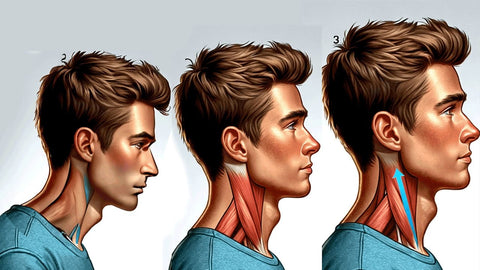Introduction
Are you ready to transform your breathing, posture, and facial development through proper mewing technique? This comprehensive guide will teach you the correct way to mew as a beginner, focusing on tongue posture fundamentals that support both aesthetic and health benefits. Whether you're dealing with mouth breathing issues, poor posture, or want to enhance your jawline naturally, mastering proper mewing technique is your first step.
Mewing works by training your tongue to rest in the optimal position against your palate, which influences facial development, breathing patterns, and overall postural alignment. This connection between tongue posture and your nervous system creates far-reaching benefits throughout your entire body.
The Science Behind Mewing and Tongue Posture
The relationship between tongue posture and facial development is rooted in the principles of neuroplasticity and myofunctional therapy. When your tongue maintains proper contact with the palate, it stimulates mechanoreceptors that send signals to your brain's sensory processing centers, influencing muscle tone and postural alignment throughout your body.
Proper tongue posture supports the natural development of the maxilla (upper jaw) and promotes nasal breathing, which is essential for optimal oxygen intake and nervous system function. This neurological connection explains why mewing can improve not just facial aesthetics, but also breathing efficiency and postural balance.
7 Essential Mewing Techniques for Beginners
1. Find the Correct Tongue Position

The foundation of proper mewing technique starts with positioning your tongue correctly against the roof of your mouth. This position should feel natural and sustainable throughout the day.
How to find the correct position:
- Place the tip of your tongue just behind your front teeth without touching them
- Press the middle and back of your tongue gently against the entire palate
- Ensure your whole tongue makes contact with the roof of your mouth
- Avoid pressing only the tip - the entire tongue surface should be engaged
2. Practice Proper Lip Seal

Maintaining a proper lip seal is crucial for successful mewing and supports the transition from mouth breathing to nasal breathing.
How to achieve proper lip seal:
- Keep your lips gently closed without tension
- Breathe exclusively through your nose
- Allow your teeth to be slightly apart, not clenched
- Relax your facial muscles while maintaining the seal
3. Master the Swallow Test

The swallow test helps you identify and maintain the correct mewing position by using your natural swallowing reflex as a guide.
How to perform the swallow test:
- Place some saliva in your mouth
- Swallow while keeping your tongue against the palate
- Notice how your tongue naturally contacts the roof of your mouth
- Maintain this position after swallowing is complete
4. Start with Soft Mewing

Soft mewing involves applying gentle, consistent pressure against the palate. This technique is perfect for beginners and can be maintained throughout the day.
How to practice soft mewing:
- Apply light pressure with your entire tongue against the palate
- Use only 10-20% of your maximum tongue strength
- Focus on consistency rather than intensity
- Practice this position while breathing, talking, and eating
5. Practice Consistent Nasal Breathing

Nasal breathing is essential for successful mewing and supports the neurological benefits of proper tongue posture.
How to maintain nasal breathing:
- Keep your mouth closed and breathe only through your nose
- Focus on slow, deep breaths through your nasal passages
- Practice nasal breathing during exercise and daily activities
- Use the tongue position to naturally promote nasal airflow
6. Build Duration Gradually
Building endurance with proper tongue posture takes time and consistent practice. Start slowly and increase duration as your tongue muscles strengthen.
Progressive training schedule:
- Week 1-2: 10-15 minute focused sessions
- Week 3-4: 30-minute sessions throughout the day
- Month 2: Maintain position for several hours
- Month 3+: Natural, unconscious tongue posture habit
7. Monitor Your Progress

Tracking your mewing progress helps maintain motivation and allows you to adjust your technique for optimal results.
How to monitor progress:
- Take weekly photos from multiple angles
- Note improvements in breathing quality and sleep
- Track changes in jaw tension and neck posture
- Document energy levels and cognitive clarity
Advanced Tips for Better Results
Combine with Postural Integration
Mewing works synergistically with overall postural correction. The tongue is part of your body's three-legged stool system - along with your feet and eyes - that determines neurological balance and spinal alignment. Address tongue posture without correcting foot function and visual coordination, and compensation patterns will limit your results.
This is why the Fix My Posture Bundle exists - to address all three systems simultaneously. When your feet, eyes, and jaw work together properly, the neurological reset creates lasting postural improvements and enhanced mewing results.
Advanced Mewing Support
For those seeking professional-grade tongue posture training, our Functional Activator accelerates mewing progress by maintaining optimal tongue positioning 24/7, especially during sleep when conscious control is impossible.
Understanding Mewing and the Nervous System
Mewing doesn't just reshape your face - it fundamentally changes how your nervous system processes sensory information. When your tongue maintains proper contact with the palate, it stimulates thousands of mechanoreceptors that communicate with your brain's postural control centers. This sensory input helps regulate muscle tone throughout your entire body, from your jaw down to your feet.
The connection between tongue posture and nervous system function explains why proper mewing technique can improve breathing efficiency, reduce neck tension, and enhance overall postural alignment. To learn more about this fascinating connection, explore our detailed guide on understanding the jaw-posture connection.
When to Expect Results
Most beginners notice immediate improvements in breathing quality and postural awareness when they achieve correct tongue posture. The neurological benefits of proper tongue positioning begin working immediately - you'll feel more grounded, breathe more efficiently, and experience less jaw tension within days of consistent practice.
Facial development changes are more gradual, typically becoming noticeable after 3-6 months of consistent mewing. The key is understanding that you're retraining your nervous system's default patterns, which takes time but creates lasting transformation when done correctly.
Watch: Complete Mewing Tutorial for Beginners
This comprehensive video demonstrates all 7 mewing techniques covered in this guide. Watch along to see proper tongue positioning, breathing methods, and common mistakes to avoid.
Video Summary: Learn step-by-step mewing instructions including correct tongue posture, swallow test technique, and how to build mewing habits that last.
Frequently Asked Questions
How long does it take to see results from mewing?
Most beginners notice improved breathing and posture within 2-4 weeks. Facial structure changes typically become visible after 3-6 months of consistent practice.
Can mewing help with mouth breathing problems?
Yes, proper tongue posture naturally promotes nasal breathing by supporting correct jaw alignment and opening nasal passages.
Is mewing safe for beginners to practice?
When done correctly with gentle pressure, mewing is safe for beginners. Start slowly and avoid excessive force to prevent jaw strain.
Can adults benefit from mewing techniques?
Yes, adults can improve breathing, posture, and facial muscle tone through proper mewing technique, though changes may be more gradual than in younger individuals.
What's the difference between hard mewing and soft mewing?
Soft mewing uses gentle, sustainable pressure and can be maintained throughout the day. Hard mewing involves intense pressure for short periods and should only be done by experienced practitioners.
Conclusion
Mastering proper mewing technique is a journey that requires patience, consistency, and understanding of the underlying neurological principles. By following these seven essential techniques and focusing on gentle, sustainable practice, you can achieve significant improvements in breathing, posture, and facial development.
Remember that mewing is part of a larger postural system that includes your feet, eyes, and jaw working together. For comprehensive results that address your body's complete neurological network, consider integrating mewing with other postural correction methods.
Start with just 10-15 minutes of focused practice daily and gradually build your endurance. With consistent effort and proper technique, mewing can become a natural, beneficial habit that supports your long-term health and well-being.
References:
- Proffit, W. R., Fields, H. W., & Sarver, D. M. (2019). Contemporary orthodontics. Elsevier Health Sciences, 6th edition, pp. 215-240.
- Guilleminault, C., & Huang, Y. S. (2018). From oral facial dysfunction to dysmorphism and the onset of pediatric OSA. Sleep Medicine Reviews, 40, 203-214.
- Palmer, J. B., Rudin, N. J., Lara, G., & Crompton, A. W. (1992). Coordination of mastication and swallowing. Dysphagia, 7(4), 187-200.
- Mew, M. (2014). The cause and cure of malocclusion. CreateSpace Independent Publishing Platform, pp. 45-78.




